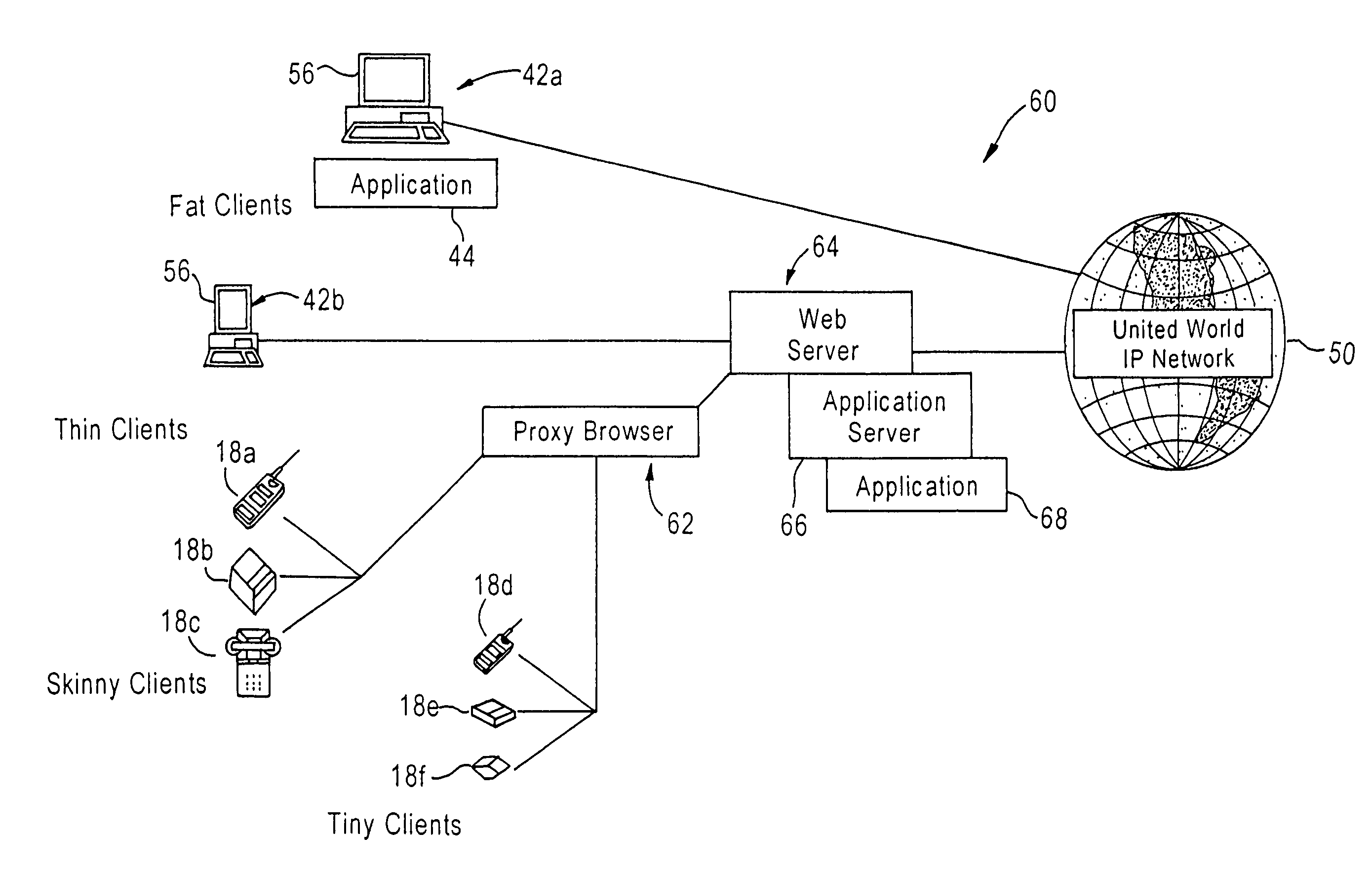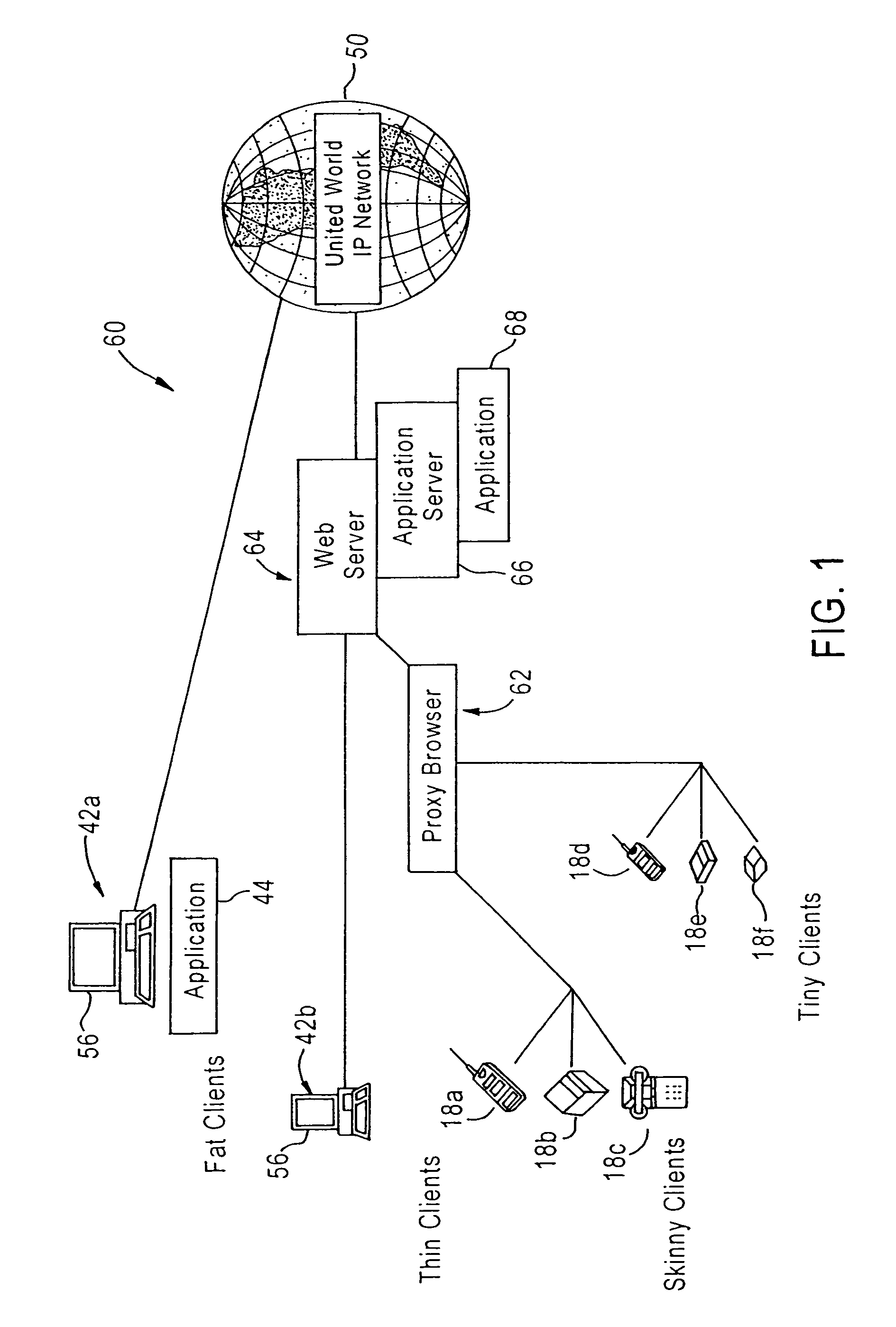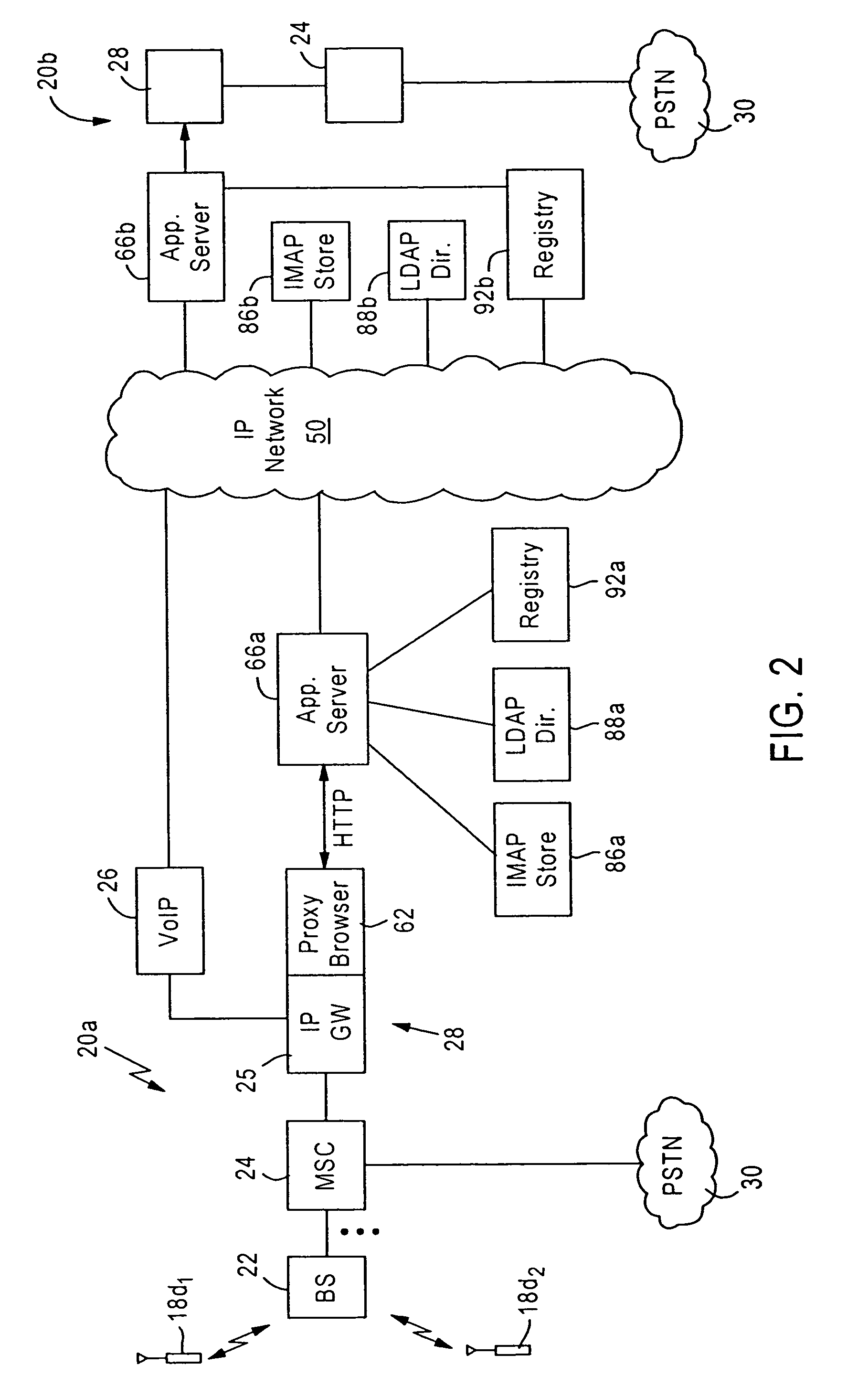[0016]There is also a need for an arrangement that enables wireless service providers to avoid the costs associated with routing calls destined for a voice messaging
system over
telephony network facilities, such as interexchange carrier facilities or international facilities.
[0017]These and other needs are attained by the present invention, where an application server, configured for executing a messaging application defined by
XML documents, is able to provide messaging services to a calling party for a remote subscriber based on retrieval of subscriber attribute information obtained from a remote information
database server (such as LDAP) via an
Internet Protocol (IP) network. The application server, upon receiving a voice application operation request having subscriber identifier information from a browser serving the calling party, obtains from the remote information
database server attribute information for responding to the voice application operation request based on the subscriber identifier information. For example the subscriber identifier information may include a dialed number identification string (DNIS) in the case of a message storage operation for a calling party attempting to reach the subscriber; alternately, the subscriber identifier information may include a
subscriber number and
password in the case of a
roaming subscriber accessing his or her message mailbox. The application server generates an
HTML document having
media content and control tags for personalized execution of the voice application operation based on the attribute information obtained from the standardized
database server. The application server also is configured for sending and retrieving messages from a standardized remote messaging server (such as IMAP) via the IP network based on a destination address specified in the subscriber attribute information. The access of the remote information database server and the standardized remote messaging server via the IP network enables the application server to provide
portable application services for
roaming subscribers or calling parties. Hence, application infrastructure can be shared among multiple servers to provide
portable application servers, eliminating the necessity of routing telephone calls across interexchange carrier facilities or international facilities.
[0018]One aspect of the present invention provides a method in an application server for executing a messaging application. The method includes receiving a first HTTP request, from a proxy browser serving a user, for execution of a prescribed messaging application operation related to a specified remote subscriber. Subscriber attribute information is obtained for the specified remote subscriber from an
Internet Protocol (IP) based database server configured for storing subscriber attributes for local subscribers and retrieving the subscriber attributes for remote subscribers from remote IP based database servers. A
Web page is generated, for execution of the prescribed messaging application operation and having
media content and control tags, based on the first HTTP request and the obtained subscriber attribute information. The method also includes accessing via an IP network an IP-based messaging server for at least one of retrieval and storage of subscriber messaging information for the specified remote subscriber, based on a prescribed messaging address retrieved from the obtained subscriber attribute information and a second HTTP request received from the proxy browser and having a reference to the prescribed messaging application operation. Hence, the application server is configured for obtaining via the IP network subscriber attributes and subscriber messaging information, even for remote subscribers having information stored on remote servers. Hence, the application server can provide
portable application services for mobile subscribers having devices lacking browser capabilities, eliminating the necessity that a mobile subscriber needs a browser to directly access a given server at the prescribed location.
[0019]Another aspect of the present invention provides a method in a wireless
communications system of storing a message for a wireless subscriber. The method includes terminating by a mobile switching center an incoming wireless
telephone call from a wireless user to a proxy device configured for generating HTTP requests and playback of media content based on selective execution of tagged information within Web pages. The method also includes initiating by the proxy device a messaging application session, related to the wireless subscriber, between the wireless user and an application server configured for generating the Web pages based on the respective HTTP requests, at least one of the HTTP requests specifying the wireless subscriber. The application server obtains subscriber attribute information related to the wireless subscriber from an Internet Protocol (IP) based database server via an IP network, and the proxy device supplies an HTTP request containing a message from the user to the application server. The application server sends the message via the IP network to an IP-based messaging server for storage based on a prescribed messaging address retrieved from the obtained subscriber attribute information. The retrieval of subscriber attribute information by the application server enables the application server to locate the prescribed messaging address for the wireless subscriber in order to send the message via the IP network, eliminating the necessity for
telephony network facilities between the mobile switching center and the wireless subscriber's messaging
system. Moreover, the retrieval of subscriber attribute information enables the application server to provide local messaging services for the wireless user via the mobile switching center, with personalized options as specified by the wireless subscriber, for example a personalized prompt.
[0020]Still another aspect of the present invention provides a method in a wireless
communications system of retrieving a stored message for a roaming wireless subscriber. The method includes terminating by a mobile switching center an incoming wireless
telephone call from the roaming wireless subscriber to a proxy device configured for generating HTTP requests and playback of media content based on selective execution of tagged information within Web pages. The method also includes initiating by the proxy device a messaging application session executed by an application server for the roaming wireless subscriber, the application server configured for generating the Web pages based on the respective HTTP requests, at least one of the HTTP requests specifying the wireless subscriber. The application server obtains subscriber attribute information related to the roaming wireless subscriber from an Internet Protocol (IP) based database server via an IP network, and obtains the stored message via the IP network from an IP-based messaging server based on a prescribed address retrieved from the obtained subscriber attribute information. The application server generates a
Web page including tags for playback of the stored message to the roaming wireless subscriber by the proxy device. The
initiation of a messaging application session with the application server enables the roaming wireless subscriber to access stored messages from remote messaging servers via the IP network, eliminating the necessity of establishing a long distance call between the mobile switching center and the roaming wireless subscriber's message store using telephony circuits. Hence, voice mail services may be provided for roaming wireless subscribers without reliance on telephony network facilities between the mobile switching center and the roaming wireless subscriber's message store.
 Login to view more
Login to view more  Login to view more
Login to view more 


